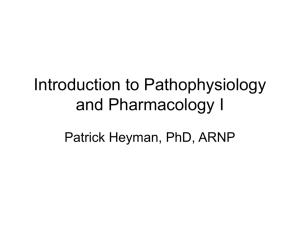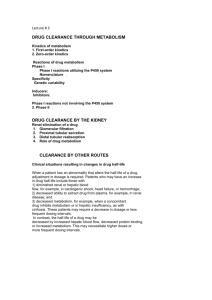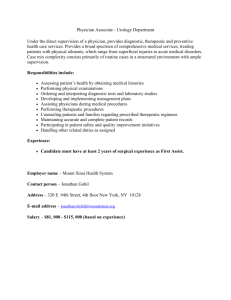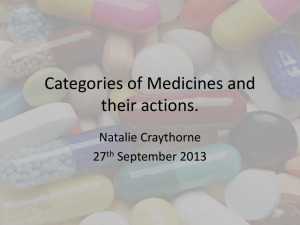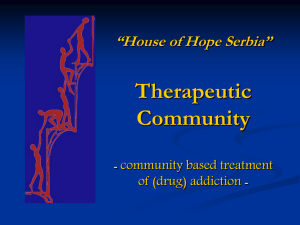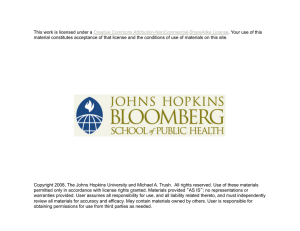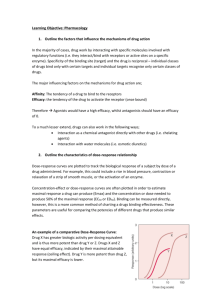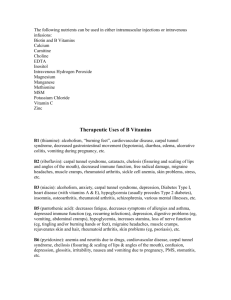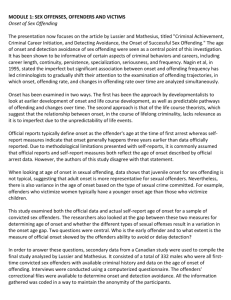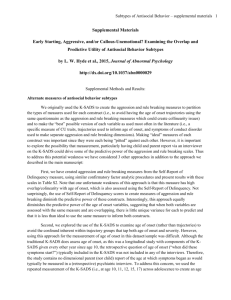CH 1 and 2 Practice Questions
advertisement
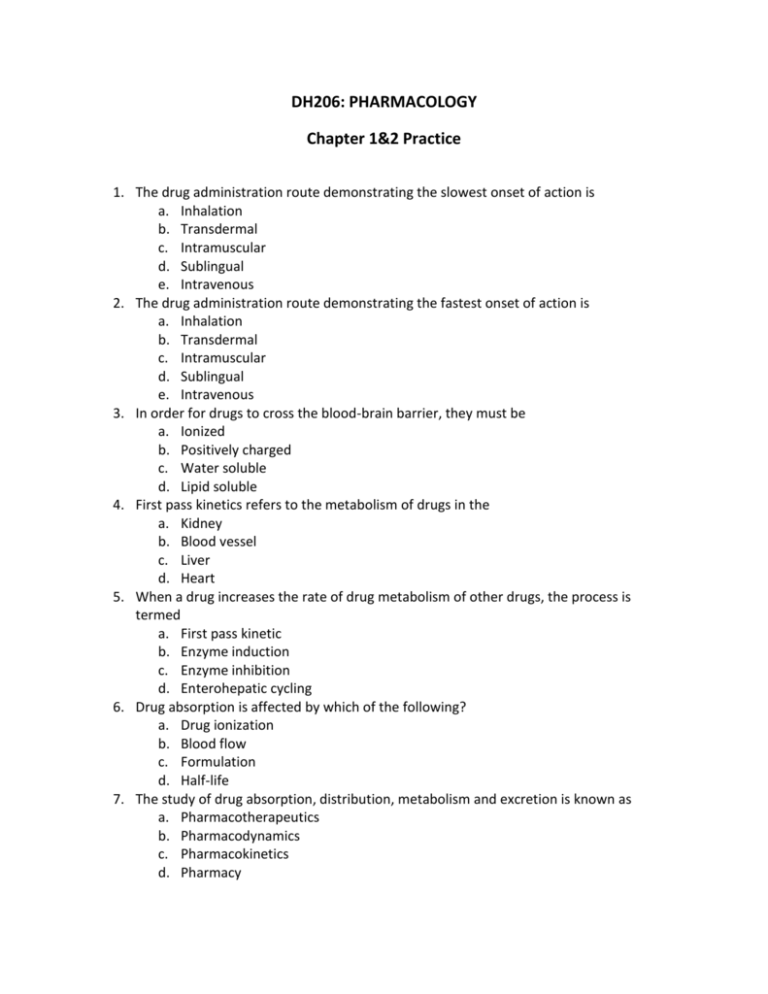
DH206: PHARMACOLOGY Chapter 1&2 Practice 1. The drug administration route demonstrating the slowest onset of action is a. Inhalation b. Transdermal c. Intramuscular d. Sublingual e. Intravenous 2. The drug administration route demonstrating the fastest onset of action is a. Inhalation b. Transdermal c. Intramuscular d. Sublingual e. Intravenous 3. In order for drugs to cross the blood-brain barrier, they must be a. Ionized b. Positively charged c. Water soluble d. Lipid soluble 4. First pass kinetics refers to the metabolism of drugs in the a. Kidney b. Blood vessel c. Liver d. Heart 5. When a drug increases the rate of drug metabolism of other drugs, the process is termed a. First pass kinetic b. Enzyme induction c. Enzyme inhibition d. Enterohepatic cycling 6. Drug absorption is affected by which of the following? a. Drug ionization b. Blood flow c. Formulation d. Half-life 7. The study of drug absorption, distribution, metabolism and excretion is known as a. Pharmacotherapeutics b. Pharmacodynamics c. Pharmacokinetics d. Pharmacy 8. The proprietary drug name supplied by a pharmaceutical company is also referred to as the a. Generic name b. OTC name c. Trade name d. Chemical name 9. The time from drug administration to the first observable drug effect is known as the a. Duration of action b. Onset of action c. Ceiling effect d. Maximal response 10. A drug that has the potential for abuse and is regulated by the Drug and Enforcement Agency is classified as a a. Poison b. OTC drug c. Prescription drug d. Controlled substance 11. A medication that does not require a physician’s service to obtain. a. Trade b. Nonproprietary c. Nonprescription d. Brand 12. Which term(s) could be associated with an agonist? a. Binding drugs b. Toxicology c. Blocking drugs d. Site of action 13. The time a drug continues to produce its effect a. Duration of action b. Maximal response c. Ceiling effect d. Onset of action 14. Conjugation of drugs with glucuronic acid to aid in metabolism occurs during which phase? a. I b. II c. III 15. To aid in excretion of drugs, the drugs need to be metabolized into ______ aqueous solutions? a. More b. Less 16. In the mouth, tetracycline is most concentrated where? a. Saliva b. Mucous membranes c. Gingival crevicular fluid d. Periodontal pocket 17. When a drug has an affinity for a receptor and produces no effect, it is called what? a. Agonist b. Competitive antagonist c. Competitive agonist d. Physiological agonist 18. Advantages of oral administration of a drug include the following EXCEPT which one? a. Large surface area for drug absorption b. Many different dosage forms may be administered orally c. More predictable response than IV d. The simplest way to introduce a drug into the body 19. Increasing the pH of a solution will cause? a. A greater percentage of a weak base in the solution to be in the ionized form b. A greater percentage of a weak acid in the solution to be in the un-ionized form c. The hydrogen ion concentration to increase d. A greater percentage of a weak base in the solution to be in the un-ionized form e. No change in the relative ionization of weak acids or weak bases 20. When the acidity of the tissue increases, as in instances of infection, the effect of a local anesthetic decreases. Therefore, the local anesthetic is a weak acid. a. Both statements are TRUE b. Both statements are FALSE c. The first statement is TRUE, the second is FALSE d. The first statement is FALSE, the second is TRUE 21. Which discipline is concerned with the rates of the rise and fall of drug concentration in the body? a. Pharmacology b. Pharmacokinetics c. Pharmacognosy d. Drugology 22. The metabolite formed during biotransformation/metabolism is usually ____ polar. a. More b. Less 23. The half-life of a drug is most related to its: a. Duration b. Potency c. Efficacy d. Onset e. Time of peak concentration 24. What route is used to administer the tuberculosis skin test? a. IV b. IM c. Intradermal d. Subcutaneous 25. Enterohepatic circulation of a drug involves the secretion of a metabolized drug into the intestine. If enterohepatic circulation is blocked, the level of the drug in the serum will fall. a. Both statements are TRUE b. Both statements are FALSE c. The first statement is TRUE, the second is FALSE d. The first statement is FALSE, the second is TRUE 26. Which of the following processes in the kidney can result in retention of a drug in the body? a. Glomerular filtration b. Active tubular secretion c. Passive tubular diffusion d. All of the above 27. If a drug displays zero-order elimination kinetics. SELECT ALL THAT APPLY a. Elimination increases as the dose of the drug is increased b. A constant amount is eliminated per unit of time c. The drug is not eliminated and is retained in the body d. The elimination of the drug cannot be predicted mathematically 28. Drugs, after undergoing Phase I drug metabolism, are more likely to be distributed to fat tissue. a. True b. False 29. If a drug is a weak base that is excreted via the kidneys, then acidifying the urine will enhance its excretion. a. True b. False 30. A prodrug is an inactive drug compound that becomes transformed into an active drug compound. a. True b. False 31. The route of administration of a drug affects both the onset and duration of response. a. True b. False 32. Therapeutic index is a measure of a drug’s safety. A narrow therapeutic index would indicate a drug is very safe and has great variability in its dosing which would help avoid toxicity. a. Both statements are TRUE b. Both statements are FALSE c. The first statement is TRUE, the second is FALSE d. The first statement is FALSE, the second is TRUE 33. Free drugs in the body exert the drugs pharmacological effects. a. True b. False 34. Lipophilic drugs are more readily excreted than hydrophilic drugs. a. True b. False 35. A lipophilic drug will cross cell membranes passively. a. True b. False 36. When an acidic drug is placed in basic solution, the product will be mostly unionized. a. True b. False 37. Water soluble drug must pass through Phase I and Phase II biotransformation in order to be excreted from the body. a. True b. False 38. In an assessment of drug action for a certain therapeutic agent, results indicate that the ED50 is 3 mg/kg, and the LD50 is 300 mg/kg. What is the therapeutic index for this agent? a. 3 b. 300 c. 0.01 d. 100 39. Although drug A and drug B have the same ED50, drug B has a wider therapeutic index, therefore drug A is considered safer. a. True b. False 40. The greater the therapeutic index is, the greater the toxicity will be. a. True b. False 41. Describe pKa in your own words. How does this affect drug absorption? 42. Describe kinetics in your own words. 43. Describe Phase I and Phase II biotransformation in your own words. ANSWERS 1.B 2.E 3.D 4.C 5.B 6.A 7.C 8.C 9.B 10.D 11.C 12.A 13.A 14.B 15.A 16.C 17.B 18.C 19.D 20.C 21. B 21.B 22.A 23.A 24.C 25.A 26.C 27.C, D 28.B 29.A 30.A 31. A 32. C 33. A 34. B (be sure you know why) 35. A (be sure you know why) 36. B (be sure you know why) 37. B (be sure you know why) 38. D 39. B 40. B
